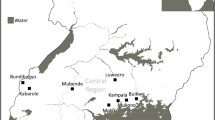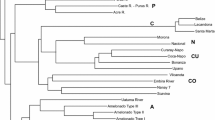Abstract
Cacao (Theobroma cacao L.) is a tropical rainforest tree that is indigenous to the Amazon region of South America. The myriad of river basins present in the Upper Amazon are where the largest diversity of cacao populations is found. Although it is generally accepted that cacao was first cultivated in Mesoamerica, there is evidence for domestication in South America, the center of origin. “Piura Porcelana” is a traditional cacao variety from northern Peru that is cultivated for the gourmet chocolate market. The demand for fine-flavored cacao used in high-end chocolates and the corresponding premium prices paid for distinct cacao flavors provide economic incentives for the use and conservation of these traditional varieties. In the present study, we compared the genetic identity of Piura Porcelana cacao with 11 known cacao germplasm groups existing in the ex situ cacao genebanks, along with the living wild populations from the Santiago and Morona river valleys in northern Peru. The results of SNP analysis showed that Piura Porcelana shares the same general population membership with the “Nacional” cacao from Ecuador. However, Piura Porcelana significantly differed from Nacional (Fst = 0.185, P < 0.001), suggesting its unique genetic status. The high genetic similarity between Piura Porcelana and newly collected wild cacao suggested that the wild progenitors of Pirua Porcelana were from these river valleys, and this traditional variety could have been the result of independent domestication in northern Peru. These results provide new evidence of cacao domestication in the Amazon and will contribute to the sustainable use and conservation of these cacao genetic resources.





Similar content being viewed by others
Abbreviations
- SNP:
-
Single-nucleotide polymorphism
- DNA:
-
Deoxyribonucleic acid
- SSR:
-
Simple sequence repeat
- RNase A:
-
Ribonuclease I or ribonucleate 3′-pyrimidinooligonucleotidohydrolase
- PCR:
-
Polymerase chain reaction
- IFC:
-
Integrated fluidic circuit
- PCoA:
-
Principle coordinate analysis
- STA:
-
Specific target amplification
References
Argout X, Fouet O, Wincker P, Gramacho K, Legavre T, Sabau X, Risterucci A, da Silva C, Cascardo J, Allegre M, Kuhn D, Verica J, Courtois B, Loor G, Babin R, Sounigo O, Ducamp M, Guiltinan MJ, Ruiz M, Alemanno L, Machado R, Phillips W, Schnell R, Gilmour M, Rosenquist E, Butler D, Maximova S, Lanaud C (2008) Towards the understanding of the cocoa transcriptome: production and analysis of an exhaustive dataset of ESTs of Theobroma cacao L. generated from various tissues and under various conditions. BMC Genomics 9:512
Argout X, Salse J, Aury JM, Guiltinan M et al (2011) The genome of Theobroma cacao. Nat Genet 43:101–109
Barrau J (1979) Sur l’origine du cacaoyer, Theobroma cacao Linne, Sterculiacées. J d’Agr Trad Bot Applied 26:171–180
Bartley BGD (2005) The genetic diversity of cacao and its utilization. CAB international, CABI Publishing, Wallingford
Cheesman EE (1944) Notes on the nomenclature, classification and possible relationships of cocoa populations. Trop Agric 21:144–159
Clement CR, de Cristo-Araújo M, d’Eeckenbrugge GC, Pereira AA, Picanço-Rodrigues D (2010) Origin and domestication of native Amazonian crops. Diversity 2:72–106. https://doi.org/10.3390/d2010072
Coe SD, Coe MD (1996) The true history of chocolate. Thames & Hudson, London
Cuatrecasas J (1964) Cacao & its allies, a taxonomic revision of the genus Theobroma. In Contributions From The United States National Herbarium, Washington, DC: Smithsonian Institution 35: 379–614
Dias LAS (2001) Origin and distribution of Theobroma cacao L.: A new scenario. In: Dias LAS (ed) Genetic improvement of cacao. FAO. http://ecoport.org/ep?SearchType=earticleView&earticleId=197&page=−2. Accessed 25 March 2013
Dieringer D, Schlötterer C (2003) Microsatellite analyser (MSA): a platform independent analysis tool for large microsatellite data sets. Mol Ecol Notes 3:167–169
Fang WP, Meinhardt LW, Mischke S, Bellato CM, Motilal L, Zhang D (2014) Accurate determination of genetic identity for a single cacao bean, using molecular markers with a nanofluidic system, ensures cocoa authentication. J Agric Food Chem 62(2):481–487
Felsenstein J (1989) PHYLIP-phylogeny inference package (version 3.2). Cladistics 5:164–166
Fluidigm (2013) Fluidigm® SNP genotyping analysis software user guide. Rev I1, PN 68000098, South San Francisco, CA, Fluidigm Corporation. https://wwwmsciencecomau/upload/pages/fluidigmtech/fluidigm-snp-genotyping-user-guide-151112pdf. Accessed 10 July 2013
Gómez-Pompa A, Flores JS, Fernandez MA (1990) The sacred cacao groves of the Maya. Lat Am Antiq 1:247–257
Henderson JS, Joyce RA, Hall GR, Hurst WJ, McGovern PE (2007) Chemical and archaeological evidence for the earliest cacao beverages. Proc Natl Acad Sci 104:18937–18940
Ji K, Zhang DP, Motilal L, Boccara M, Lachenaud P, Meinhardt LW (2013) Genetic diversity and parentage in farmer varieties of cacao (Theobroma cacao L.) from Honduras and Nicaragua as revealed by single nucleotide polymorphism (SNP) markers. Genet Resour Crop Evol 60:441–453
Loor GR, Fouet O, Lemainque A et al. (2012) Insight into the wild origin, migration and domestication history of the fine flavour Nacional Theobroma cacao L variety from Ecuador. PLoS ONE 7: e48438. https://doi.org/10.1371/journal.pone.0048438
Lukman L, Zhang D, Susilo AW, Dinarti D, Bailey B, Mischke S, Meinhardt LW (2014) Genetic identity, ancestry and parentage in farmer selections of cacao from Aceh, Indonesia revealed by single nucleotide polymorphism (SNP) markers. Trop Plant Biol 7:133–143
Motamayor JC, Lachenaud P, da Silva e Mota JW, Loor R, Kuhn DN, Brown JS, Schnell RJ (2008) Geographic and genetic population differentiation of the Amazonian chocolate tree (Theobroma cacao L). PLoS ONE 3(10):e3311. https://doi.org/10.1371/journal.pone.0003311
Motilal L, Zhang D, Umaharan P, Mischke S, Mooleedhar V, Meinhardt LW (2010) The relic Criollo cacao in Belize- genetic diversity and relationship with Trinitario and other cacao clones held in the international cocoa Genebank, Trinidad. Plant Genet Resour-Charact Util 8:106–110
Nei M, Tajima F, Tateno Y (1983) Accuracy of estimated phylogenetic trees from molecular data. II Gene frequency data. J Mol Evol 19(1983):153–170
Peakall R, Smouse PE (2006) Genalex 6: genetic analysis in excel. Population genetic software for teaching and research. Mol Ecol Notes 6:288–295
Peakall R, Smouse PE (2012) GenAlEx 6.5: genetic analysis in excel. Population genetic software for teaching and research-an update. Bioinformatics 28:2537–2539
Pound FJ (1945) A note on the cocoa population of South America. In Report and Proceedings of the 1945 Cocoa Conference, London, U.K., pp. 131–133
Pritchard JK, Stephens M, Donnelly P (2000) Inference of population structure from multilocus genotype data. Genetics 155:945–959
Rambaut A (2009) Molecular evolution, phylogenetics and epidemiology: FigTree v1.3.1 2006–2009. http://tree.bio.ed.ac.uk/software/figtree/. Accessed 14 April 2017
Saitou N, Nei M (1987) The neighbor-joining method: a new method for reconstructing phylogenetic trees. Mol Biol Evol 4:406–425
Turnbull CJ, Hadley P (2016) International Cocoa Germplasm Database (ICGD). [Online Database]. UK: CRA Ltd./ICE Futures Europe/University of Reading, Available at http://www.icgd.reading.ac.uk. Accessed 15 May 2017
Wang J, Lin M, Crenshaw A, Hutchinson A, Hicks B, Yeager M, Berndt S, Huang WY, Hayes RB, Chanock SJ, Jones RC, Ramakrishnan R (2009) High throughput single nucleotide polymorphism genotyping using nanofluidic dynamic arrays. BMC Genomics 10:561
Wood GAR (1985) History and development. In: Wood GAR, Lass RA (eds) Cocoa, 4th edn. Blackwell Science, Oxford, pp 1–10
Zarrillo S, Gaikwad N, Lanaud C et al. (2018) The use and domestication of Theobroma cacao during the mid-Holocene in the upper Amazon. Nature Ecology & Evolution 2:1879-1888
Zhang D, Motilal L (2016) Origin, dispersal and current global distribution of cacao genetic diversity. In: Bailey BA, Meinhardt LW (eds) Cacao diseases: a history of old enemies and new encounters. Springer, Cham, pp 3–31
Zhang D, Boccara M, Motilal L, Mischke S, Johnson ES, Butler DR, Bailey B, Meinhardt LW (2009a) Molecular characterization of an earliest cacao (Theobroma cacao L) collection from Peruvian Amazon using microsatellite DNA markers. Tree Genet Genomes 5:595–607
Zhang D, Mischke BS, Johnson ES, Mora A, Phillips-Mora W, Meinhardt LW (2009b) Molecular characterization of an international cacao collection using microsatellite markers. Tree Genet Genomics 5:1–10
Zhang D, Mischke S, Meinhardt LW (2012) Genetic diversity and spatial structure in a new distinct Theobroma cacao L. population in Bolivia. Genet Resour Crop Evol 59:239–252
Acknowledgements
Authors would like to acknowledge Rey Loor Solorzano, Wilberth Phillips-Mora, and Brian Irish for supplying the samples. Authors also express appreciation to Stephen Pinney for SNP genotyping and Sue Mischke for reviewing and editing this manuscript. References to a company and/or product by the USDA are only for the purposes of information and do not imply approval or recommendation of the product to the exclusion of others that may also be suitable.
Author information
Authors and Affiliations
Corresponding author
Ethics declarations
Conflict of interest
The authors declare that they have no conflict of interest.
Data archiving statement
All row data for the Peruvian germplasm and the reference trees are being submitted to the International Cacao germplasm Database (http://www.icgd.rdg.ac.uk/).
Additional information
Communicated by L.A. Meisel
Publisher’s Note
Springer Nature remains neutral with regard to jurisdictional claims in published maps and institutional affiliations.
Electronic supplementary material
ESM 1
(DOCX 21 kb)
Rights and permissions
About this article
Cite this article
Arevalo-Gardini, E., Meinhardt, L.W., Zuñiga, L.C. et al. Genetic identity and origin of “Piura Porcelana”—a fine-flavored traditional variety of cacao (Theoborma cacao) from the Peruvian Amazon. Tree Genetics & Genomes 15, 11 (2019). https://doi.org/10.1007/s11295-019-1316-y
Received:
Revised:
Accepted:
Published:
DOI: https://doi.org/10.1007/s11295-019-1316-y




